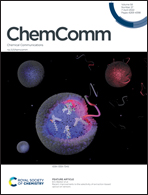Bimodal photocatalytic behaviour of a zinc β-diketiminate: application to trifluoromethylation reactions†
Abstract
A photoactive zinc β-diketiminate complex spans a wide redox window of 3.97 V at its excited state. Having a highly reducing excited-state potential, it generates an electrophilic trifluoromethyl radical by the reductive cleavage of triflyl chloride. This leads to trifluoromethylation of a set of arenes and heteroarenes. During the oxidative quenching of the photocatalyst, a ligand-centered radical cation is formed, which has been detected by spectroelectrochemical EPR measurement.



 Please wait while we load your content...
Please wait while we load your content...